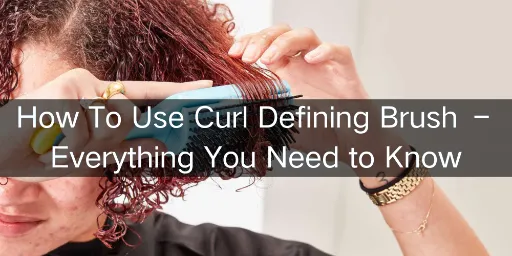To create, clarify and fix your natural curl, you need a curl defining brush. The importance of selecting the best curl defining brush is that each of the types has varied effects on wavy, curly, or coily hair. The proper step-by-step procedure on how to apply a curl defining brush will help in making definition smooth, frizz-free and lasting. This guide will take you through styles, methods, and pro secrets in order to become a master of styling without any doubt. Continue reading to learn how to get your best curls ever.
Bounce Curl Defining Brushes - Purpose and Functionality
A curl defining brush can assist you to de-tangle, clump curls, minimize frizz, and define without heat. Its boar, nylon, or vegan bristles hold and straighten your hair cuticles to give it a smooth look. It curls rather than straightens hair as opposed to regular brushes. It is synergistic with the porosity and elasticity of your hair that assists you in encouraging and extending your natural curl pattern. Proper use will allow you to get smooth, clean, and healthy-looking curls.
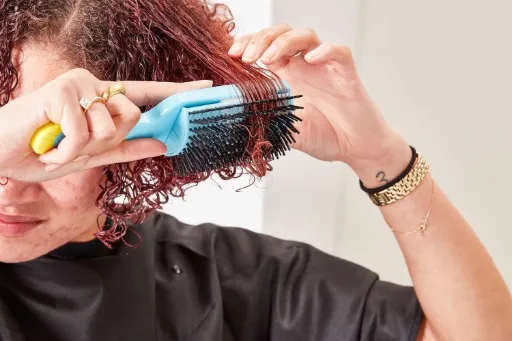
Types of Best Curl Defining Brushes
Edge-Lift Brushes

The Bounce Curl Define EdgeLift is a five-in-one product that straightens, shapes, separates the hair and adds volume to the roots. Its bendable bristles are able to go with any type of curls. It is versatile but still needs some practice. It will come in particularly handy when you need to get some lift at the roots and clean, sharp lines all at once.
Pin-Based Brush or Double-Blade Brushes
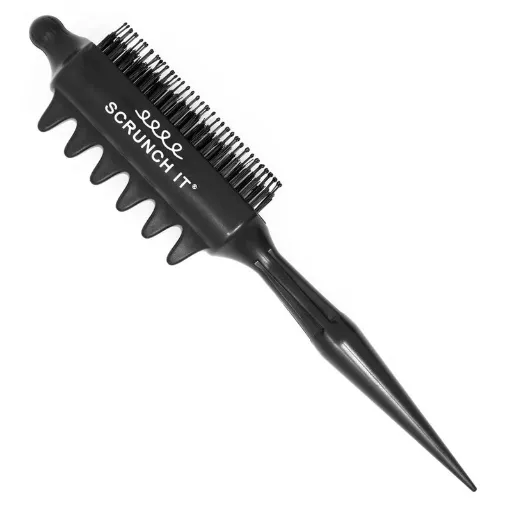
Scrunchit brushes have pins to provide accurate curl definition, particularly fine or medium curls. They decrease frizz though may not be effective with dense or coily hair. It is the best type in case you want lightweight tools that provide precise outcomes without providing too much manipulation to your hair.
Boar Bristle Variants

Boar bristle brushes even out cuticles and spread natural oils to give a shine to the coarse or dry curls. And they are most effective at dry styling, rather than wet curl setting. You can depend on them to provide finishing touches to make your curls look healthy and polished.
Vegan and Biodegradable Alternative

Brushes that are composed of PLA or synthetic bristles are environmentally friendly and fit every type of curl. They are sustainable and can wear out more quickly than nylon. This option will enable you to take care of your curls and the environment without sacrificing quality styling.
Specialty Brushes
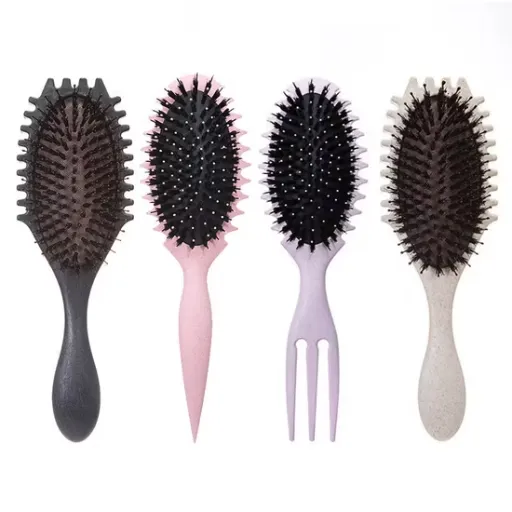
Tangle Teezer, wide toothcombs, and ergonomic cat-head shapes work on sensitive scalps in a gentle detangling way. They are portable, yet not as defining as structured curl brushes. They are ideal when you appreciate comfort, compactness and less tension on the scalp when styling.
| Brush Type | Key Features | Materials | Suitability | Pros | Cons |
|---|---|---|---|---|---|
| Wet Brush Original Detangler | Customizable rows (7-9), stiff bristles, ergonomic handle | Nylon bristles, rubber cushion, plastic handle | Curly (3A-4A), thick hair, styling with gel/cream | Durable, excellent clump definition, customizable | Can poke scalp if used aggressively, not ideal for fine hair |
| Paddle-Style Brushes | Broad flat surface, wide bristle spacing, e.g., Denman D3 | Nylon or mixed bristles, cushioned plastic base | Wavy (2A-2C), curly (3A-3C), medium to long hair | Efficient product distribution, smooths curls | May be too large for short hair, less precise for tight coils |
| Edge-Lift Brushes (e.g., Bounce Curl Define EdgeLift) | 5-in-1 design: smooths, separates, defines, parts, heatless curls; flexible bristles | Boar bristles, plastic handle, eco-friendly options | All curl types (2A-4C), short to long hair | Versatile, enhances root volume, precise parting | Higher price point, requires technique learning |
| Double-Blade/Pin-Based Brushes (e.g., Scrunchit) | Dual bristles/pins, lightweight, targeted curl definition | Plastic pins, flexible plastic body | Wavy (2A-2C), fine to medium curls | Precise for finer curls, reduces frizz | Less effective for dense/coily hair, may need multiple passes |
| Boar Bristle Variants | Dense natural bristles, smooths cuticles | Boar bristles, wood/plastic handle | Curly (3B-4C), coarse/dry hair | Distributes natural oils, adds shine | Not ideal for wet styling, can be heavy |
| Vegan/Biodegradable Options | Eco-friendly, e.g., PLA-based brushes | PLA (plant-based plastic), synthetic bristles | All curl types, eco-conscious users | Sustainable, lightweight | May lack durability of nylon, limited availability |
| Specialty Brushes (e.g., Tangle Teezer, Wide-Tooth Combs, Cat-Head Designs) | Flexible teeth, ergonomic shapes, wide combs for detangling | Plastic, silicone, or mixed materials | Wavy to coily (2A-4C), sensitive scalps | Gentle, travel-friendly, unique designs | Less effective for heavy styling, not all define curls well |
Selecting the Right Curl Defining Brush for Natural Hair
- Length and thickness of hair– Fine hair, which is short, needs smaller brushes with softer bristles. Larger, thicker hair are best suited to firm, wide-row designs. Good fit leads to a balanced distribution of a product and avoids excessive breakage.
- Styling objectives– Select fluffy brush such as Bounce Curl EdgeLift or Denman D3 smooth, even curls. Tangle Teezer provides a soothing detangling on sensitive scalps. The best brush to use is the one that is matched to your style preference which is time saving and consistent.
- Budget and affordability– Budget brushes are good everyday brushes, whereas higher-end brushes are long-lasting and have advanced properties. Quality investment might be expensive to buy but can serve years with good care.
- Testing procedures- In-store check bristle flexibility and handle grip. When purchasing online, read user reviews and before and after pictures. The testing will make sure the brush is comfortable to hold and that it works on your type of curl.
Hair Types Compatible with Curl Defining Brushes
- Wavy hair (2A-2C):You can improve loose waves, using the brush to build some soft clumps without burdening them. Use sections that are larger and light creams to make the movement natural.
- Curly hair (3A-3C):Curly hair is the major beneficiary of curl defining brushes since they provide the hair with well-formed clumps. There is bounce, shine, and less frizz when brushing on wet hair using the appropriate tension.
- Coily (4A-4C):Employ the brush primarily to untangle and define the curl and keep shrinkage intact. Use it with deep conditioners or creams to have slip and protection.
- Fine and coarse textures:Soft bristles are recommended to avoid breakage in case of fine hair. The stiff bristles can be used on coarse hair to distribute the products. Adjust brushing pressure according to porosity and thickness at all times.
- Length factors:Curl defining brushes are easy to use on longer than 3 inch hair, where there is space to clump and shape the hair. In shorter styles, smaller brushes or changing techniques will also help prevent pulling.
- Unsuitable type:These brushes are not suitable on straight hair since they will not give permanent curls. In case your hair is very weak or damaged, repair treatments should be your priority before you brush it to avoid breakage.
Essential Preparation Before Using a Curl Defining Brush
Learning how to use a curl defining brush can be effective only after you have prepared your hair. The step will make the styling process easier, provide more definition and healthier curls.
- Hair cleaning schedule:Use shampoo and conditioner in the sequence of cleaning and moisturizing. Wash it out to the point where your hair is wet. This aids the brush to move freely and clumps curls naturally.
- Product usage:Spread the use of curl creams, gels, or oils evenly throughout roots to the ends. They contain slip and frizz control, and curl pattern locking. Rake products through using your fingers prior to brushing.
- Tools required:Have sectioning clips to section your hair so that you can style evenly. Wipe off the excess water using microfiber towel without abrading the cuticle. Have a mirror around to be precise.
- Hair condition evaluation:Look at the dryness, breakage, and tangles. Repair breakage by using intense conditioning prior to styling to prevent additional tension on the strands.
How to use a curl defining brush? Step-by-Step
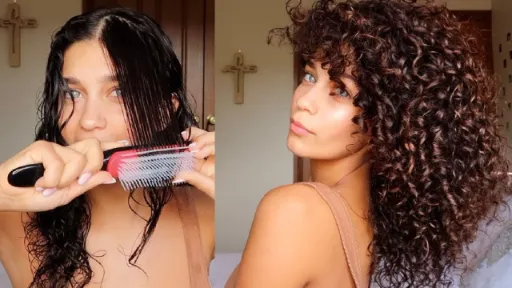
Step 1: Preliminary detangle using a wide-tooth comb
You have to take away knots or tangles before using your curl defining brush. Comb with a wide-tooth comb on wet hair. This will avoid breakage and your curls will be formed smoothly. The first step is detangling, which makes the process of brushing easier and more effective.
Step 2: Divide hair into manageable sections
Split your hair into small manageable portions. Each section can be fastened with clips. By doing in sections, you can work on each area and provide your curls with the same amount of definition, decreasing frizz.
Step 3: Spread product evenly
Apply your favorite curl cream, gel, or leave-in conditioner to every section. Ensure that all the strands are coated to allow maximum curl formation. Correct product usage will give you clumpy, crisp curls and give you hold without rigidity.
Step 4: Brush through section with light tension
With your curl defining brush, run it through each section in smooth downward motions. Use a light tension to form the curl without breaking it. Concentrate on working with your natural curl direction as opposed to forcing the hair.
Step 5: Lift and scrunch to obtain volume
Once you have brushed, lift the hair at the roots and scrunch it down to your scalp. This method helps to increase volume and curl clumping. You may continue scrunching until you achieve the bounce you want.
Step 6: Diffuse or air dry
Lastly, air dry, or diffuse the curls on low heat. Do not rub your hair after it is drying too much to avoid frizziness. When dry, it is easy to break clumps apart to create a more natural, fuller appearance.
Effective Curling Techniques for Wavy Hair
- Upright vs. upside-down brushing:Brush upright if you want to add a bit of volume to your natural wave or flip your hair upside-down to lift the roots and add more bounce. The two approaches assist in defining the waves in various ways according to the style you want.
- Clump size changes: Larger pieces of hair should be used to achieve looser, beachy waves. The smaller sections make a tighter, more specific wave, so adjust according to the style you wish.
- Product combinations:To create a definition without heaviness, apply light creams or mousses to your curls. Also, you may incorporate some gel to help with hold and maintain the texture soft.
- Case examples:You will find dramatic improvement in comparison of before-and-after. Natural wave patterns are visibly improved with proper sectioning, brushing direction and product usage.
Effective Curling Techniques for Curly Hair
- Volume with root lift: There is the option of increasing the natural volume of your hair using the edge-lift option of a curl defining brush. Begin with the roots, lifting strands with a brush and brushing up. It does not flatten your curls, but rather adds height.
- Forming ringlets:To help make specific ringlets, it is possible to take smaller strands of hair and wind them around the handle of the brush. Keep a few seconds, and then release slowly. It is a curl-enhancing technique that enables your hair to stay bouncy and consistent in form.
- Frizz control:With bristle smoothing techniques, you can minimize frizz. Slowly brush each section, starting at the roots to the tip, so that the bristles can straighten the cuticles and spread natural oils or styling products evenly. This gives smooth, shaped curls.
Effective Curling Techniques for Coily Hair
- Soft detangling emphasis:You must never detangle hastily and roughly to prevent breaking. Wet, conditioned hair, brush with a wide-tooth comb or use your curl defining brush. Use small links and begin at the ends and work toward the roots.
- No stretching:You are capable of increasing your coils without lengthening them. Use the curl cream or gel and define the clumps with your fingers or brush, but do not brush out the natural shrinkage. Do not over brush or pull.
- Scalp access:You are expected to access your scalp properly with the help of pins or sectioning clips. This makes the distribution of the product even, increases circulation, and avoids accumulation at the roots.
Benefits of Using a Curl Defining Brush
A curl defining brush has several advantages that take your curly hair experience to another level. This is how it can make your curls polished, healthy and manageable:
- Increased definition of curls:You are able to produce medium sized clumped curls with ease. The brush separates the clumps of hair and smooths the edges, making your curls defined and polished.
- Root lift and volume:The added height can be created by pressing down on roots without flattening your hair. The method also adds natural bounce to your curls and makes them look fuller.
- Frizz control:You can apply an even layer of the curl creams, gels, or even leave-in products with the brush. This reduces flyaways, tames cuticles, and tames frizz.
- Economical on time in styling:The brush saves you a lot of time compared to when you are finger coiling or doing other manual techniques in styling your hair and gives you consistent results.
- Health benefits to the hair:The gentle tension does not cause breakage, and the brush enables more product absorption, which makes curls stronger and shinier.
- Flexibility of styles:Your brush is versatile to wet styling, dry refreshing or even heatless curling, so it is a very versatile tool to all your curly hair needs.
Potential Drawbacks and Risks
- Breakage:When you brush your hair with too much force, you may overload your hair shaft and cause breakage of your hair and split ends. Apply firm, smooth strokes at all times.
- Learning curve:At the beginning of using it, you might see initial frizz or uneven curl patterns. The correct method to use on your hair takes practice.
- Cost:High-end brands such as Bounce Curl Define EdgeLift can provide a variety of features, although low-end brands might not be durable. Think about your hair requirements and investment.
- Curl defining brushes:The hair curling brushes need to be cleaned regularly to avoid product accumulation that may interfere with the performance and health of the hair.
Common Mistakes and How to Avoid Them
- Dry hair brushing:At no time should you brush dry hair. Dry brushing makes the hair frizzier and prone to curl breakage.
- Missing detangling:A failure to detangle prior to brush use may result in knots, tension, and damage. Wide-tooth comb first.
- Inappropriate clump sizes:Using the wrong clump size can result in uneven curls because of the mismatch between the clump size and your natural curl. Section as per your hair type.
- Over-tension:Brushing roughly, by pulling too hard, stretches hair and breaks cuticles. Keep it lightly pressed to smooth, clean-cut curls.
- Non-use of products:Missed curl creams or gels lack slip and control, which cause frizz and definition imbalance.
Conclusion
The art of how to use a curl defining brush can help to make your curls neat and bouncy instead of messy and undefined. Selecting the right curl defining brush, depending on your hair type, whether that be the Bounce Curl Define EdgeLift or a traditional Denman, will provide the best possible curl clumping, frizz control and volume. A correct sequential process will ensure you do not break, have uneven patterns and product buildup. You will learn how to create wavy, curly and coily hair with practice. Begin experimenting now, and have healthy, defined curls daily.

